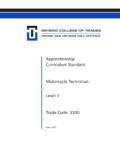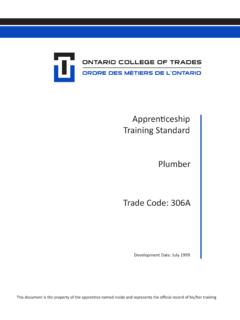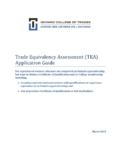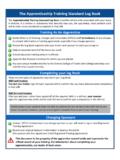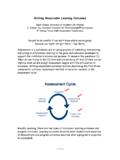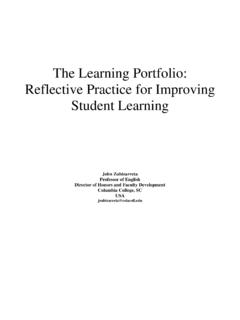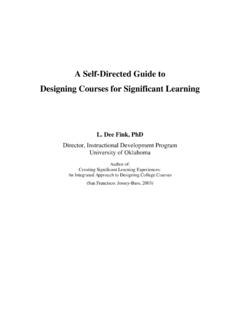Transcription of Electrician: Construction & Maintenance Industrial
1 Apprenticeship Curriculum Standard electrician : Construction & Maintenance Industrial Domestic & Rural Level 1, 2 and 3. Trade Codes: 309A, 309C, 442A. Date: 2003. Please Note: Apprenticeship Training and Curriculum Standards were developed by the Ministry of Training, Colleges and Universities (MTCU). As of April 8th, 2013, the Ontario College of Trades (College) has become responsible for the development and Maintenance of these standards. The College is carrying over existing standards without any changes. However, because the Apprenticeship Training and Curriculum Standards documents were developed under either the Trades Qualification and Apprenticeship Act (TQAA) or the Apprenticeship and Certification Act, 1998 (ACA), the definitions contained in these documents may no longer be accurate and may not be reflective of the Ontario College of Trades and Apprenticeship Act, 2009 (OCTAA) as the new trades legislation in the province.
2 The College will update these definitions in the future. Meanwhile, please refer to the College's website ( ) for the most accurate and up-to-date information about the College. For information on OCTAA and its regulations, please visit: Ontario College of Trades . electrician APPRENTICESHIP IN-SCHOOL CURRICULUM. TABLE OF CONTENTS. INTRODUCTION .. 4. IMPLEMENTATION .. 5. SUMMARY OF HOURS .. 6. LEVEL 1: BASIC. CANADIAN ELECTRICAL CODE .. 7. PRINTS .. 10. ELECTRICAL THEORY .. 12. INSTALLATION METHODS .. 14. INSTRUMENTATION.
3 16. ELECTRONICS .. 19. LEVEL 2: INTERMEDIATE. CANADIAN ELECTRICAL CODE .. 22. PRINTS .. 24. ELECTRICAL THEORY .. 26. INSTALLATION METHODS .. 29. INSTRUMENTATION .. 31. ELECTRONICS .. 34. MONITORING & COMMUNICATION SYSTEMS .. 36. LEVEL 3: ADVANCED. CANADIAN ELECTRICAL CODE .. 39. PRINTS ( Construction AND Maintenance ONLY) .. 41. ELECTRICAL THEORY .. 43. INSTALLATION METHODS .. 47. INSTRUMENTATION .. 50. FLUID POWER ( Industrial ONLY) .. 53. ELECTRONICS .. 57. 2. Ontario College of Trades . electrician APPRENTICESHIP IN-SCHOOL CURRICULUM.
4 Note: Level one and two courses are common for apprentices registered in both the Construction and Maintenance and Industrial electrician programs. The third level, Construction and Maintenance apprentices are required to take all courses except Fluid Power. Industrial apprentices are required to take all courses except Prints Level 3. 3. Ontario College of Trades . electrician APPRENTICESHIP IN-SCHOOL CURRICULUM. APPRENTICE electrician IN-SCHOOL CURRICULUM. INTRODUCTION. This Curriculum Standard has been developed in keeping with the related Ministry of Training, Colleges and Universities (MTCU) Training Standard.
5 The Curriculum Standard provides a standard of theoretical knowledge and practical application to complement the on-the-job experiences of apprentices. The design of the Curriculum Standard facilitates cross-referencing between in-school learning outcomes and related workplace performance objectives as defined in the Training Standard for the trade. Apprentices, therefore, are expected to complete the learning associated with these objectives by applying the prescribed in-school knowledge to the required practical experiences in the work setting.
6 Innovation and the use of complex equipment in trades are resulting in increasing demands for tradespersons who are not only skilled in the practical aspects of the trade, but who also have a sound theoretical knowledge. The objectives of the Curriculum Standard, therefore, are to provide a basis for: a. Sound theoretical training to meet the challenges presented by innovation and increasingly complex tools and equipment within the work environment. b. Reinforcement of fundamental proficiency in the trade through the practice of work skills as identified in specific Learning Outcomes.
7 C. Development of a high standard of trade craftsmanship and problem-solving skills. d. Development of a desirable work attitude and a keen sense of responsibility, particularly concerning public and personal safety. To assure maximum consistency in delivery, a time allocation has been included for each reportable subject, along with a theoretical and practical breakdown of the Learning Content. While setting out content requirements as determined by the Provincial Advisory Committee and the Industry Committee and as prescribed in the Acts and Regulations for the trades, the Curriculum Standard has been designed to give the instructor every reasonable opportunity for flexibility and innovation in curriculum development, lesson planning and delivery.
8 In all practical learning activities, the apprentices will abide by the Occupational Health and Safety Act and all other regulations and policies relating to safety, particularly the use of personal protective equipment. As a general guideline, a time allocation has been included for each respective course and unit. More detailed time allocations for the user have been provided for each topic area to assure consistency in delivery for each student intake. 4. Ontario College of Trades . electrician APPRENTICESHIP IN-SCHOOL CURRICULUM.
9 To ensure that successful students will be capable of achieving the Learning Outcomes according to the performance criteria, specific times have been allocated in the respective areas to allow for practical skills development. IMPLEMENTATION. Basic September 2003. Intermediate September 2004. Advanced September 2005. 5. Ontario College of Trades . electrician APPRENTICESHIP IN-SCHOOL CURRICULUM. SUMMARY OF HOURS. BASIC. No. Title Hours Hours Total Theory Practical CANADIAN ELECTRICAL CODE 33 - 33. PRINTS 30 - 30.
10 ELECTRICAL THEORY 63 - 63. INSTALLATION METHODS - 48 48. INSTRUMENTATION 12 12 24. ELECTRONICS 21 21 42. TOTAL HOURS: 159 81 240. INTERMEDIATE. No. Title Hours Hours Total Theory Practical CANADIAN ELECTRICAL CODE 39 - 39. PRINTS 30 - 30. ELECTRICAL THEORY 81 - 81. INSTALLATION METHODS - 39 39. INSTRUMENTATION 21 21 42. ELECTRONICS 20 19 39. MONITORING & COMMUNICATION SYSTEMS 10 20 30. TOTAL HOURS: 201 99 300. ADVANCED. No. Title Hours Hours Total Theory Practical CANADIAN ELECTRICAL CODE 30 - 30. PRINTS (C & M only) 30 - 30.

